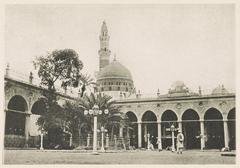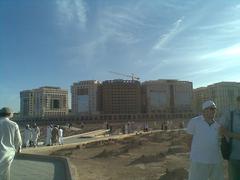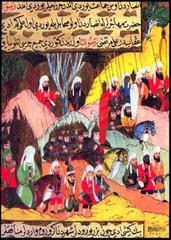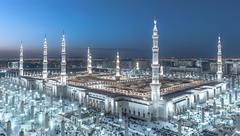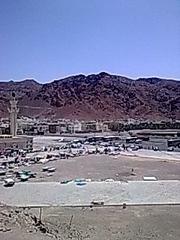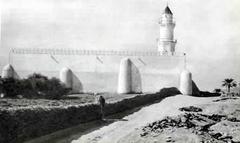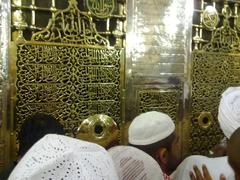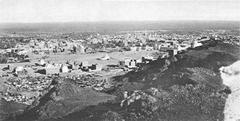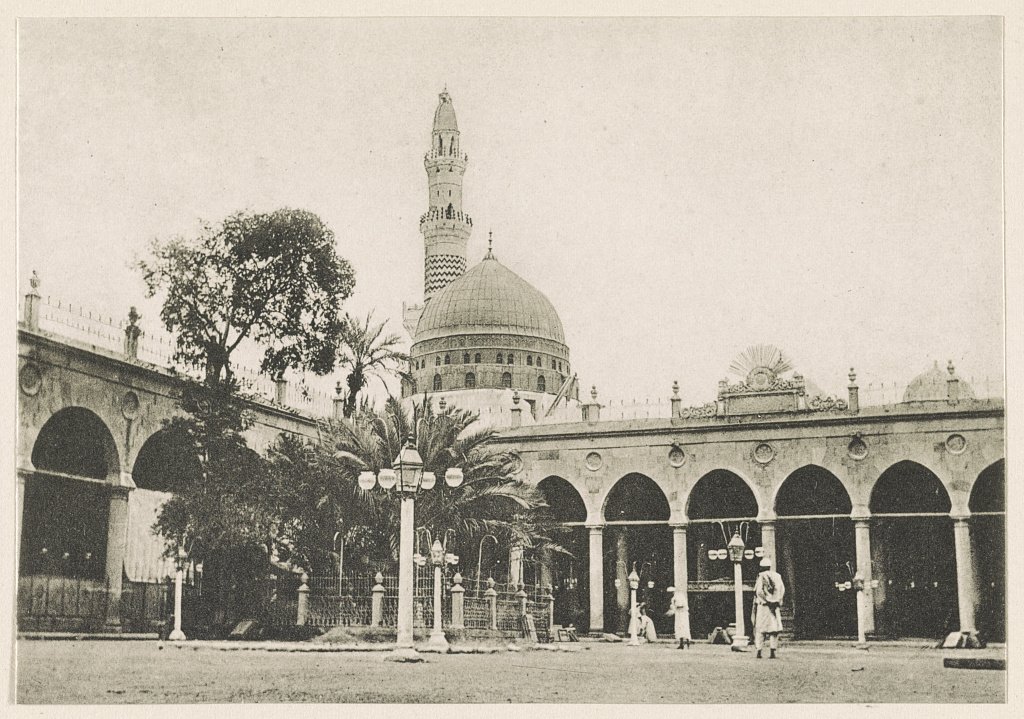
Prophet’s Mosque Visiting Hours, Tickets, and Historical Sites Guide
Date: 14/06/2025
Introduction
Al-Masjid an-Nabawi, or the Prophet’s Mosque, stands at the heart of Medina, Saudi Arabia, as the second holiest site in Islam after Masjid al-Haram in Mecca. Established by Prophet Muhammad (PBUH) in 622 CE after his migration from Mecca, the mosque is not only a revered place of worship but also a living testament to early Islamic society, serving as a community hub, educational center, and administrative headquarters. Over centuries, the mosque has evolved architecturally and culturally, reflecting the rich tapestry of Islamic dynasties and their contributions (madainproject.com; Islamic Landmarks).
This guide provides an in-depth look at the Prophet’s Mosque’s historical background, visitor information, architectural highlights, etiquette, accessibility, and nearby historical sites—equipping you for a respectful and enriching visit to Medina.
Historical Background and Architectural Evolution
Early Foundations: 7th Century
The Prophet’s Mosque began as a modest, open-air structure with mud-brick walls and a palm-trunk roof. It was built on land purchased by the Prophet Muhammad and served multiple roles, including a prayer space, school, and administrative center. The mosque’s original dimensions were approximately 30.5 by 35.6 meters (madainproject.com).
Early Expansions and Modifications
The first major expansion came in 629 CE, funded by Uthman ibn Affan, increasing the mosque’s size and comfort. Around 623/24 CE, following a divine revelation, the qiblah (direction of prayer) changed from Jerusalem to Mecca, influencing the mosque’s orientation and architecture.
Caliphate Era Enhancements
Rashidun caliphs Umar and Uthman further expanded the mosque, using stone pillars and teak wood for greater durability. The Umayyad Caliph al-Walid I introduced marble columns, mosaics, and four minarets. The Green Dome, now an iconic feature, was constructed over the Prophet’s tomb during this era. The Abbasids continued artistic and structural enhancements (destinationksa.com).
Mamluk and Ottoman Contributions
The Mamluk period saw the addition of new domes and significant restoration works, while the Ottomans, particularly Suleiman the Magnificent and Abdulmecid I, expanded the prayer hall, introduced additional domes, and painted the Green Dome its characteristic color in 1837 (madainproject.com).
Modern Saudi Expansions
Modern expansions under the Saudi rulers, especially King Fahd’s 1985–1994 project, increased the mosque’s capacity to over one million worshippers and incorporated advanced facilities such as sliding domes and escalators, while maintaining the site’s spiritual atmosphere (madainproject.com).
Visitor Information
Visiting Hours
Al-Masjid an-Nabawi is open 24 hours daily for prayers and visitation. However, access to certain areas, such as the Rawdah (the area between the Prophet’s tomb and pulpit), is regulated and may require waiting, especially during peak periods (Swiss International Taba Al Salam).
Entry and Ticketing
Entry to the mosque is free for Muslims. No tickets or fees are required. During peak times (Ramadan, Hajj, Fridays), crowd control measures and permits for specific zones like the Rawdah may be enforced (Swiss International Taba Al Salam; Saudi Ministry of Hajj and Umrah).
Dress Code
- Men: Long trousers and sleeved shirts. Traditional attire is optional.
- Women: Abaya (full-length robe) and headscarf required. The face and hands may remain uncovered (Adventure to Every Country).
- Footwear: Remove shoes before entering prayer areas (Visit Al Madinah).
Accessibility
The mosque is equipped with ramps, elevators, and wheelchair-accessible facilities. Staff are available to assist those with mobility needs.
Etiquette and Behavior
- Maintain silence and reverence.
- Set phones to silent.
- Do not eat or drink inside prayer areas.
- Photography is discouraged in sensitive areas, especially near the Prophet’s tomb and Rawdah (Karma Adve).
Security
Expect security checks at all entrances. Carry identification, and be aware that non-Muslims are not permitted inside the mosque or city center (Besides the Obvious).
Key Sites Within Al-Masjid an-Nabawi
The Green Dome and Prophet’s Tomb
The Green Dome marks the resting place of Prophet Muhammad, Abu Bakr al-Siddiq, and Umar ibn al-Khattab. The adjacent Rawdah, with its green carpet, is considered a “garden from Paradise” and is among the most sacred spaces for prayer (mytravelation.com; agoda.com).
The Minbar and Mihrab
The Prophet’s minbar (pulpit) and the mihrab (prayer niche) remain focal points for worship and reflection. The current minbar is ornately decorated, and the mihrab marks where the Prophet led prayers (wildtrips.net).
Expansive Courtyards and Umbrellas
The mosque’s courtyards feature electronically operated umbrellas, providing shade for thousands of worshippers and creating a distinctive visual experience (rjtravelagency.com).
The Library
The mosque’s library offers access to rare manuscripts and Islamic historical documents, supporting scholarship and public education (wildtrips.net).
Notable Sites Surrounding Al-Masjid an-Nabawi
- Al-Baqi Cemetery: Burial site of many of the Prophet’s family and companions (nomadicsamuel.com).
- Quba Mosque: The first mosque in Islam, built by the Prophet himself (mytravelation.com).
- Qiblatain Mosque: Marks the site where the qibla was changed from Jerusalem to Mecca (wildtrips.net).
- The Seven Mosques (Sab’ah Masajid): Commemorate key moments from the Battle of the Trench.
- Uhud Mountain: Site of the pivotal Battle of Uhud and graves of martyrs (mytravelation.com).
- Al-Madina Museum: Showcases artifacts and exhibits on Medina’s history (wildtrips.net).
- Madina Dates Market: A bustling market known for a wide variety of dates and local products (agoda.com).
Practical Travel Tips
- Best Visiting Times: Early morning and late evening are less crowded; November–March offers cooler weather.
- Accommodation: Book hotels well in advance, especially during peak seasons (The Traveler’s Buddy).
- Transport: Taxis and ride-hailing apps are available. Many sites are within walking distance.
- Language: Arabic is official; English is widely spoken in hotels and by mosque staff.
- Hydration: Medina’s climate is dry; carry water (outside the mosque).
- Cultural Sensitivity: Use respectful greetings, avoid photographing worshippers without consent, and observe local customs (Besides the Obvious).
Frequently Asked Questions (FAQ)
Q: What are the official visiting hours for Al-Masjid an-Nabawi?
A: The mosque is open 24/7, but access to certain areas like the Rawdah is regulated.
Q: Is there an entry fee or ticket required?
A: No, entry is free for Muslims.
Q: Are guided tours available?
A: Yes, authorized guided tours can be arranged.
Q: Can non-Muslims visit the mosque or Medina?
A: Non-Muslims are not permitted inside the mosque or central Medina; they may enjoy the city’s markets and view the mosque from designated areas.
Q: What is the dress code?
A: Modest attire is required; abayas and headscarves for women, long trousers and sleeved shirts for men.
Conclusion
Visiting Al-Masjid an-Nabawi is a profound spiritual and historical experience, offering insight into the legacy of the Prophet Muhammad and the evolution of Islamic civilization. By understanding the mosque’s history, following proper etiquette, and exploring the rich array of nearby sites, visitors can ensure a respectful and fulfilling journey.
For real-time updates, prayer times, mosque maps, and personalized visitor guides, download the Audiala app. Explore our website for further articles on Medina’s historical sites and Saudi Arabia travel tips.
Sources and Further Information
- Madain Project: Visiting Al-Masjid an-Nabawi—History, Tickets, Hours & Travel Tips
- Islamic Landmarks: Facts About Masjid al-Nabawi
- Swiss International Taba Al Salam: A Comprehensive Guide to Visiting Al-Masjid an-Nabawi
- MyTravelation: Medina Guide
- Destination KSA: Construction History of the Prophet’s Mosque
- IslamQA: Etiquette of Visiting the Prophet’s Mosque
- Karma Adve: Exploring the Sacred Medina
- Wild Trips: Medina Travel Guide and Historical Sites
- TripXL: Medina Mosque Guide and Travel Tips
